This commentary was originally published in February, but given that South Sudan has just celebrated independence over the weekend, we thought it apt to re-publish.
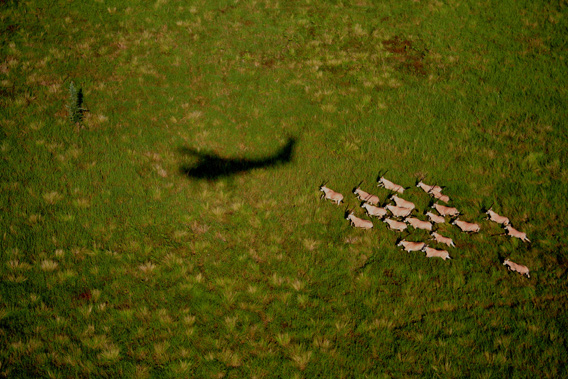
Oryx and WCS Cessna shadow, Boma National Park. Photo by Paul Elkan and J. Michael Fay. ©2007 National Geographic/ Wildlife Conservation Society.
After the people of South Sudan have voted overwhelmingly for independence, the work of building a nation begins. Set to become the world’s newest country on July 9th of this year, one of many tasks facing the nation’s nascent leaders is the conservation of its stunning wildlife. In 2007, following two decades of brutal civil war, the Wildlife Conservation Society (WCS) surveyed South Sudan. What they found surprised everyone: 1.3 million white-eared kob, tiang (or topi) antelope and Mongalla gazelle still roamed the plains, making up the world’s second largest migration after the Serengeti. The civil war had not, as expected, largely diminished the Sudan’s great wildernesses, which are also inhabited by buffalo, giraffe, lion, bongo, chimpanzee, and some 8,000 elephants.
“I have never seen wildlife like that, in such numbers, not even when flying over the mass migrations of the Serengeti,” said survey leader and renowned conservationist J. Michael Fay in 2007.
However, with new nationhood comes tough decisions and new pressures. Multi-national companies seeking to exploit the nation’s vast natural resources are expected to arrive in South Sudan, tempting them with promises of development and economic growth, promises that have proven uneven at best across Africa. Dubbed the resource curse, many poor nations have seen their rich, natural resources plundered for the world market, but instead of reaping the financial rewards, money is lost in poorly-made deals or commodity swings, or ends up in the pockets of foreign corporations or corrupt officials, leaving the nation’s people not with education and opportunity, but environmental degradation and social unrest. Dependent on oil (98% of the government’s revenue comes from oil) and shockingly poor (90% of the people live on less than a dollar a day), South Sudan is perfectly situated for a resource-curse repeat.
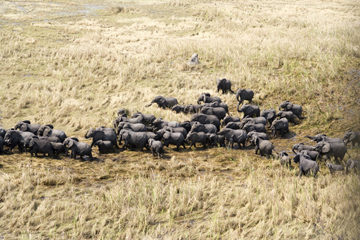
Herd of elephants in the Sudd wetlands. Photo by Paul Elkan and J. Michael Fay ©2007 National Geographic/ Wildlife Conservation Society |
One way to avoid the resource curse is to expand one’s economic portfolio from non-renewable resources, such as oil and mining, to opportunities that won’t stagnate. Here’s where the nation’s vast wildlife—and its still intact ecosystems—come in.
“There is a historic opportunity, perhaps unprecedented, for wildlife conservation, sustainable natural resource management and environmentally friendly ecotourism to be integrated into the nation-building process,” Steven Sanderson CEO of WCS wrote in an op-ed last month on CNN.
With some of the continent’s biggest herds—and therefore some of the best wildlife viewing in the world—South Sudan could become an eco-tourism hub. Tourism in such a place is nothing to sniff at: Kenya estimated it would make over $1 billion in revenue from tourism in 2010. And unlike oil, tourism doesn’t run dry, so long as South Sudan makes forward-thinking conservation a priority.
“The case for conservation is clear: The protection of parkland and wildlife must be a rallying point for Southern Sudan. Animal migrations, along with pristine savanna and wetland habitat, could become one of the greatest tourism attractions in Africa and a key component of Southern Sudan’s growth and economic security,” Sanderson added in his editorial.
One of the nation’s key problems will be how to preserve its stunning migration. The world’s land-migrations have largely vanished over the last century, and even today Tanzania is threatening its famed wildebeest migration with a cross-country road project. South Sudan should learn from this: every development project should be weighted carefully over whether it would negatively impact the migration, the main draw for tourism.
But wealth could come from more than tourism and should be measured as more than GDP. Protecting watersheds and forests will greatly benefit the people of South Sudan, who are mostly agriculturalists and herders, by preserving precious ecosystem services. Smart partnerships with open-minded NGOs could help the people of Sudan grow more food, gain improved heath care, receive education, improve infrastructure, and essentially live better while preserving their ecosystems.
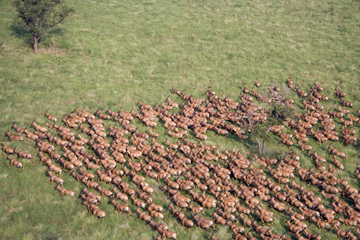
Tiang herd in the Southern sector of Boma National Park. Photo by Paul Elkan and J. Michael Fay ©2007 National Geographic/ Wildlife Conservation Society |
Another opportunity waits in the wings for South Sudan if it chooses conservation over complete exploitation. As the burgeoning ecosystem market takes off, South Sudan could in time see financial investments for forward thinking preservation efforts. While the nation’s remaining rainforests would be its first target, future prospects could include watersheds and biodiversity contingent on the broadening of such ecosystem service payments.
Already the South Sudan government is showing optimistic foresight. Last month, it asked investors to support its underfunded parks with $140 million.
“We want to create another source of income other than oil,” Daniel Wani, undersecretary for wildlife at the Ministry of Wildlife, Conservation and Tourism, told Reuters. “The potential of tourism can encourage people to come.”
The $140 million would help fix-up South Sudan’s vast network of parks and add infrastructure for what it hopes will be its first tourists, including guard posts, roads, airstrips, and hotels. Of course, such infrastructure must be smartly planned, so it doesn’t degrade the ecosystems people have come to visit. The country has also recruited 16,000 former soldiers for wildlife guards. Given poaching and bushmeat rates across Africa, park guards are essential to protecting South Sudan’s wildlife.
Of course, though, as the nation opens up and the companies swarm with promises, the temptation for the government will be short-term solutions. In other words gaining as much revenue as possible by allowing companies to strip bare its natural resources—oil, mining, unsustainable logging. But it doesn’t have to repeat the resource curse. If the South Sudan heeds the stories of other nations on the continent, it may find that vast, rapid, and unplanned exploitation does not lead to a better life for its people or to political stability, but the opposite. Even if the rewards of conservation come slower, they will come. In an age when the world’s great renewable and necessary resources—i.e. water, forests, biodiversity—are vanishing, South Sudan, if it plays its cards right, could retain unprecedented wealth in nature and be seen as nation for a new world.
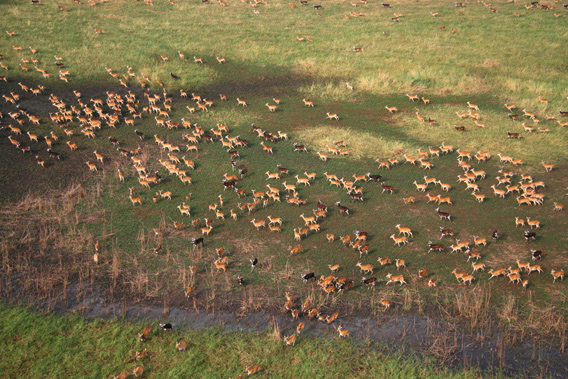
Herd of white-eared Kob migration on Kangen River, Boma National Park. Photo by Paul Elkan and J. Michael Fay ©2007 National Geographic/ Wildlife Conservation Society.
Related articles
Newest country boasts one of the world’s greatest wildlife spectacles, but protection needed
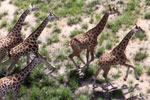
(07/10/2011) At midnight local time on Friday, South Sudan became the world’s newest nation. As celebrations continue in the new capital of Juba and congratulations come from every corner of the globe, the Wildlife Conservation Society (WCS) is urging the newborn nation to protect its ecosystems and rich wildlife in order to build a sustainable and forward-looking economy. Home to the world’s second largest land migration, South Sudan boasts an abundance of African megafauna that is becoming increasingly rare throughout much of the continent.
South Sudan’s tropical forests fast disappearing
(06/06/2011) South Sudan’s tropical montane forests are fast disappearing according to new analysis by PRINS Engineering. At current rates, Mount Dongotomea, located in South Sudan’s most biodiverse ecosystem, could be completely stripped of tree cover by 2020.
Foreign big agriculture threatens world’s second largest wildlife migration
(03/07/2011) As the world’s largest migration in the Serengeti plains—including two million wildebeest, zebra, and Thomson’s gazelles—has come under unprecedented threat due to plans for a road that would sever the migration route, a far lesser famous, but nearly as large migration, is being silently eroded just 1,370 miles (2,200 kilometers) north in Ethiopia’s Gambela National Park. The migration of over one million white-eared kob, tiang, and Mongalla gazelle starts in the southern Sudan but crosses the border into Ethiopia and Gambela where Fred Pearce at Yale360 reports it is running into the rapid expansion of big agribusiness. While providing habitat for the millions of migrants, Gambela National Park’s land is also incredibly fertile enticing foreign investment.
‘Land grab’ fears in Africa legitimate
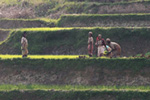 (01/31/2011) A new report by the International Institute for Environment and Development (IIED) has found that recent large-scale land deals in Africa are likely to provide scant benefit to some of the world’s poorest and most famine-prone nations and will probably create new social and environmental problems. Analyzing 12 recent land leasing contracts investigators found a number of concerns, including contracts that are only a few pages long, exclusion of local people, and in one case actually give land away for free. Many of the contracts last for 100 years, threatening to separate local communities from the land they live on. “Most contracts for large-scale land deals in Africa are negotiated in secret,” explains report author Lorenzo Cotula in a press release. “Only rarely do local landholders have a say in those negotiations and few contracts are publicly available after they have been signed.”
(01/31/2011) A new report by the International Institute for Environment and Development (IIED) has found that recent large-scale land deals in Africa are likely to provide scant benefit to some of the world’s poorest and most famine-prone nations and will probably create new social and environmental problems. Analyzing 12 recent land leasing contracts investigators found a number of concerns, including contracts that are only a few pages long, exclusion of local people, and in one case actually give land away for free. Many of the contracts last for 100 years, threatening to separate local communities from the land they live on. “Most contracts for large-scale land deals in Africa are negotiated in secret,” explains report author Lorenzo Cotula in a press release. “Only rarely do local landholders have a say in those negotiations and few contracts are publicly available after they have been signed.”
Massive wildlife population discovered in Southern Sudan
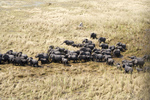
(06/12/2007) Aerial surveys by the New York-based Wildlife conservation Society found more than 1.3 million white-eared kob, tiang antelope and Mongalla gazelle in Southern Sudan, despite decades of civil war. The population, which includes more than 8,000 elephants, rivals that of the legendary Serengeti in Tanzania and suggests that the region is of critical importance for conservation efforts.
Wildlife conservation plan moves forward in southern Sudan
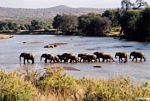 (04/03/2007) A leading conservation group announced that it has signed two agreements with the Government of Southern Sudan (GoSS) to launch a conservation strategy for the region’s wildlife. The New York-based Wildlife conservation Society says that southern Sudan may have some of the richest wildlife in Africa.
(04/03/2007) A leading conservation group announced that it has signed two agreements with the Government of Southern Sudan (GoSS) to launch a conservation strategy for the region’s wildlife. The New York-based Wildlife conservation Society says that southern Sudan may have some of the richest wildlife in Africa.